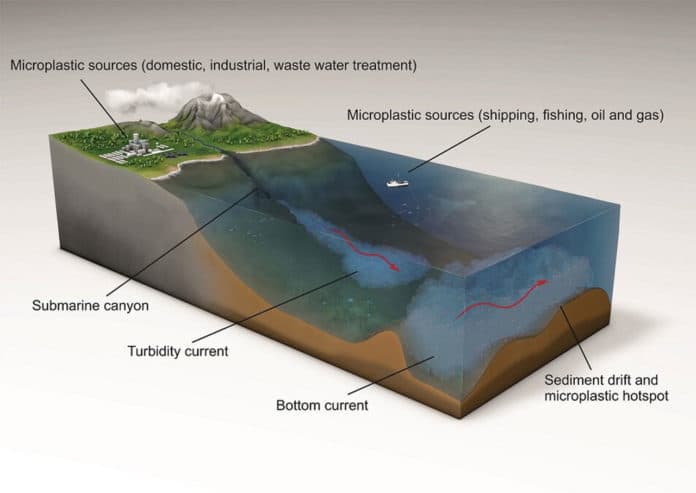More than 10 million tons of plastic waste enters the oceans every year. Floating plastic waste at sea has attracted the public’s interest on account of the ‘Blue Planet Effect’ seeing moves to debilitate the use of plastic drinking straws and transporter packs. However, such accumulations represent under 1% of the plastic that enters the world’s oceans.
The missing 99% is instead thought to occur in the deep ocean, but until now, it has been unclear where it ended up.
Now, a new study by the University of Manchester (UK), National Oceanography Centre (UK), University of Bremen (Germany), IFREMER (France), and Durham University (UK) revealed the most significant levels of microplastic ever recorded on the seafloor, with up to 1.9 million pieces in a thin layer covering only 1 square meter.
The study has shown that how deep-sea currents act as conveyor belts, transporting tiny plastic fragments and fibers across the seafloor.
These currents can concentrate microplastics inside massive sediment accumulations, which they named ‘microplastic hotspots.’ These hotspots give off the impression of being the remote ocean reciprocals of the supposed garbage patches shaped by currents on the ocean surface.
The lead author of the study, Dr. Ian Kane of The University of Manchester, said: “Almost everybody has heard of the infamous ocean ‘garbage patches’ of floating plastic, but we were shocked at the high concentrations of microplastics we found in the deep-seafloor.
“We discovered that microplastics are not uniformly distributed across the study area; instead, they are distributed by powerful seafloor currents which concentrate them in certain areas.”
The currents also carry oxygenated water and nutrients, which means microplastic seafloor hotspots can also house essential ecosystems that can consume or absorb the microplastics.
This study provides the first direct link between the behavior of these currents and the concentrations of seafloor microplastics, and the findings will help to predict the locations of other deep-sea microplastic hotspots and direct research into the impact of microplastics on marine life.
The sediment samples were collected from the seafloor of the Tyrrhenian Sea. The samples were then combined with calibrated models of deep ocean currents and detailed mapping of the seafloor.
In the laboratory, the microplastics were separated from sediment, counted under the microscope, and further analyzed using infrared spectroscopy to determine the plastic types. Using this information, the team was able to show how ocean currents controlled the distribution of microplastics on the seafloor.
Dr. Mike Clare of the National Oceanography Centre, who was a co-lead on the research, stated: “Our study has shown how detailed studies of seafloor currents can help us to connect microplastic transport pathways in the deep-sea and find the ‘missing’ microplastics. The results highlight the need for policy interventions to limit the future flow of plastics into natural environments and minimize impacts on ocean ecosystems.”
Dr. Florian Pohl, Department of Earth Sciences, Durham University, said: “It’s unfortunate, but plastic has become a new type of sediment particle, which is distributed across the seafloor together with sand, mud, and nutrients. Thus, sediment-transport processes such as seafloor currents will concentrate plastic particles in certain locations on the seafloor, as demonstrated by our research.”
Journal Reference:
- Ian A. Kane, Seafloor microplastic hotspots controlled by deep-sea circulation. DOI: 10.1126/science.aba5899
